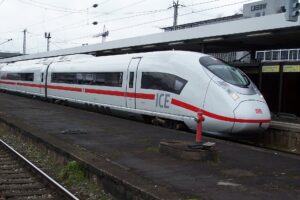New Trains
Having spent most of my weekends abroad traveling in some way or another, one thing about Germany that I’ve become incredibly familiar with is the Deutsche Bahn. For better or for worse, the DB’s IC and ICE lineup are by far the most convenient way to travel throughout Germany and has become so ubiquitous that it almost seems like trying to find a better way to travel long distances is a waste of time. With such a dominance in the industry of travel – this is in large part due to DB being a government-operated company in order to ensure its commitment to providing “reliable” travel rather than turning to more profitable routes – moves made by the Deutsche Bahn affect not only their customer base, but all of mass mobility in Germany. And just as so many people are reliant on DB for managing their travel, the DB is reliant on their trains to make such mobility possible.
One of the newest additions to the DB ICE lineup, the ICE 4 from Siemens, is an incredible example of optimization in the direction of the goals of both the DB and the Germans. The ICE 4, unveiled for the public in 2016, boasts incredible efficiency and power figures, allowing the train to move faster and easier to further increase the sustainability and convenience of train travel in Germany. The ICE model’s increased aerodynamic efficiency allows it to decrease operational energy requirements by 30% while maintaining a similar top speed to previous, more power-hungry models. The new model represents Siemens’ second shift in power delivery strategy, utilizing their decrease in operational demand to decrease the number of required power-delivering cars used per train assembly by implementing an intermittent power strategy, powering only roughly half of the train’s cars. This strategy allows the trains to even further reduce the energy requirements by removing the powerplants of several cars, generally reducing the weight of the entire assembly by about 5%. In comparison to the previous model, the Velaro D (an ICE 3 generation), which utilizes power delivered from every car, the max total power output as well as top speed are reduced in the 4th generation, but with increased efficiency by way of weight and aerodynamics in combination with the true effective requirements of the trains, the platform was seen as an improvement to the previous generation and ordered by DB, who put

roughly 50 assemblies in service in 2020. The efficiency and decreased demand of parts via the decreased number of power plants made the platform optimal for larger implementations and the new generation of ICE was introduced as an “XXL” solution.
With the unveil of the new Velaro MS model in 2021, however, the benefits of the ICE 3 platform’s higher max speed, quicker acceleration – as a result of its expansive power plant structure – and compatibility with foreign power delivery standards forced the DB to transition back to the previous platform for future purchases with new delivery of the Velaro MS – titled the ICE 3neo – taking place from 2022 to 2029. Newly purchased trains are set to begin phasing out older trains put into service in the 1990s as orders are delivered. Maybe next generation, Siemens can figure out how to make a train that arrives on time.
- Sean M.
- Deutsche Bahn. (n.d.). Ice 4. Comfier, greener and better. https://int.bahn.de/en/trains/long-distance-trains/ice_4#Details
- (n.d.). Comfort for Trans-European high-speed traffic. Siemens Mobility Global. https://www.mobility.siemens.com/global/en/portfolio/references/velaro-ms.html
- (n.d.). Fact sheet: Velaro D – New ICE 3 (Series 407).
